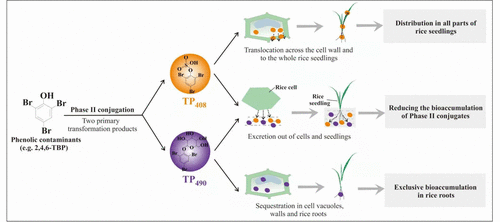当前位置:
X-MOL 学术
›
Environ. Sci. Technol.
›
论文详情
Our official English website, www.x-mol.net, welcomes your
feedback! (Note: you will need to create a separate account there.)
Compartmentalization and Excretion of 2,4,6-Tribromophenol Sulfation and Glycosylation Conjugates in Rice Plants
Environmental Science & Technology ( IF 10.8 ) Pub Date : 2021-02-05 , DOI: 10.1021/acs.est.0c07184 Qing Zhang 1, 2, 3 , Wenqian Kong 1, 2, 4 , Linfeng Wei 1, 2, 4 , Xingwang Hou 1, 2, 4 , Qianchi Ma 1, 2, 4 , Yanna Liu 1, 2 , Yadan Luo 1, 2, 4 , Chunyang Liao 1, 2, 4 , Jiyan Liu 1, 2, 4 , Jerald L Schnoor 5 , Guibin Jiang 1, 2, 4
Environmental Science & Technology ( IF 10.8 ) Pub Date : 2021-02-05 , DOI: 10.1021/acs.est.0c07184 Qing Zhang 1, 2, 3 , Wenqian Kong 1, 2, 4 , Linfeng Wei 1, 2, 4 , Xingwang Hou 1, 2, 4 , Qianchi Ma 1, 2, 4 , Yanna Liu 1, 2 , Yadan Luo 1, 2, 4 , Chunyang Liao 1, 2, 4 , Jiyan Liu 1, 2, 4 , Jerald L Schnoor 5 , Guibin Jiang 1, 2, 4
Affiliation

|
The most environmentally abundant bromophenol congener, 2,4,6-tribromophenol (2,4,6-TBP, 6.06 μmol/L), was exposed to rice for 5 d both in vivo (intact seedling) and in vitro (suspension cell) to systematically characterize the fate of its sulfation and glycosylation conjugates in rice. The 2,4,6-TBP was rapidly transformed to produce 6 [rice cells (3 h)] and 8 [rice seedlings (24 h)] sulfated and glycosylated conjugates. The predominant sulfation conjugate (TP408, 93.0–96.7%) and glycosylation conjugate (TP490, 77.1–90.2%) were excreted into the hydroponic solution after their formation in rice roots. However, the sulfation and glycosylation conjugates presented different translocation and compartmentalization behaviors during the subsequent Phase III metabolism. Specifically, the sulfated conjugate could be vertically transported into the leaf sheath and leaf, while the glycosylation conjugates were sequestered in cell vacuoles and walls, which resulted in exclusive compartmentalization within the rice roots. These results showed the micromechanisms of the different compartmentalization behaviors of 2,4,6-TBP conjugates in Phase III metabolism. Glycosylation and sulfation of the phenolic hydroxyl groups orchestrated by plant excretion and Phase III metabolism may reduce the accumulation of 2,4,6-TBP and its conjugates in rice plants.
中文翻译:

水稻植株中 2,4,6-三溴苯酚硫酸化和糖基化偶联物的区室化和排泄
环境最丰富的溴酚同源物 2,4,6-三溴酚(2,4,6-TBP,6.06 μmol/L)在体内(完整幼苗)和体外(悬液细胞)暴露于水稻 5 天系统地表征其硫酸化和糖基化结合物在水稻中的命运。2,4,6-TBP 被快速转化以产生 6 个 [水稻细胞 (3 h)] 和 8 个 [水稻幼苗 (24 h)] 硫酸化和糖基化结合物。主要的硫酸化偶联物 (TP 408 , 93.0–96.7%) 和糖基化偶联物 (TP 490, 77.1-90.2%) 在水稻根部形成后被排泄到水培溶液中。然而,硫酸化和糖基化结合物在随后的 III 期代谢过程中表现出不同的易位和区室化行为。具体来说,硫酸化偶联物可以垂直运输到叶鞘和叶片中,而糖基化偶联物则被隔离在细胞液泡和细胞壁中,从而导致水稻根部内的排他性区室化。这些结果显示了 2,4,6-TBP 缀合物在 III 期代谢中不同区室化行为的微观机制。由植物排泄和 III 期代谢协调的酚羟基的糖基化和硫酸化可能会减少 2,4,6-TBP 及其结合物在水稻植物中的积累。
更新日期:2021-03-02
中文翻译:

水稻植株中 2,4,6-三溴苯酚硫酸化和糖基化偶联物的区室化和排泄
环境最丰富的溴酚同源物 2,4,6-三溴酚(2,4,6-TBP,6.06 μmol/L)在体内(完整幼苗)和体外(悬液细胞)暴露于水稻 5 天系统地表征其硫酸化和糖基化结合物在水稻中的命运。2,4,6-TBP 被快速转化以产生 6 个 [水稻细胞 (3 h)] 和 8 个 [水稻幼苗 (24 h)] 硫酸化和糖基化结合物。主要的硫酸化偶联物 (TP 408 , 93.0–96.7%) 和糖基化偶联物 (TP 490, 77.1-90.2%) 在水稻根部形成后被排泄到水培溶液中。然而,硫酸化和糖基化结合物在随后的 III 期代谢过程中表现出不同的易位和区室化行为。具体来说,硫酸化偶联物可以垂直运输到叶鞘和叶片中,而糖基化偶联物则被隔离在细胞液泡和细胞壁中,从而导致水稻根部内的排他性区室化。这些结果显示了 2,4,6-TBP 缀合物在 III 期代谢中不同区室化行为的微观机制。由植物排泄和 III 期代谢协调的酚羟基的糖基化和硫酸化可能会减少 2,4,6-TBP 及其结合物在水稻植物中的积累。











































 京公网安备 11010802027423号
京公网安备 11010802027423号